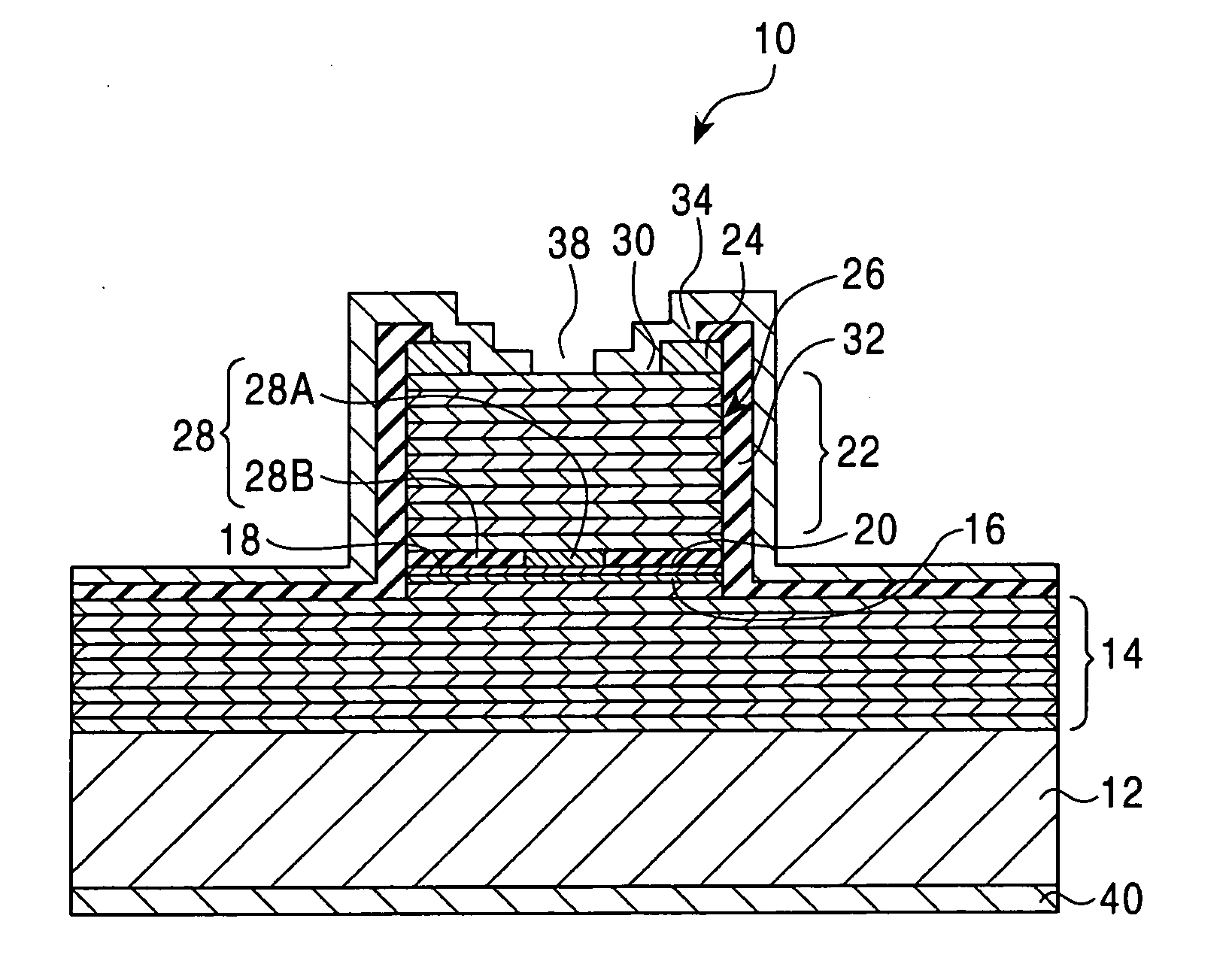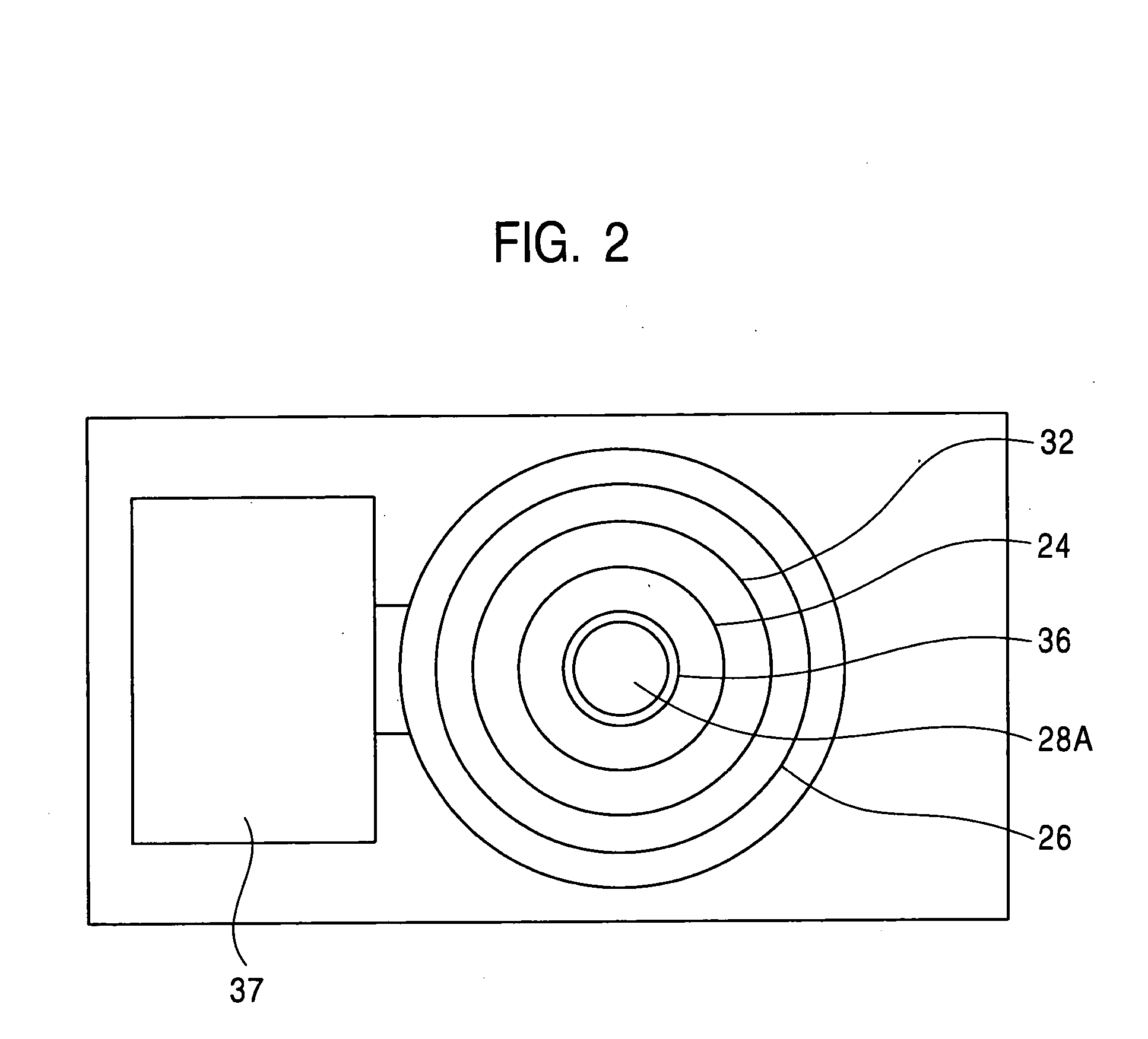Surface light emitting semiconductor laser element
a laser element and semiconductor technology, applied in semiconductor lasers, optical elements, instruments, etc., can solve the problems of significant reduction of yield, difficult to produce surface light-emitting, limited tolerance of production errors, etc., and achieve high efficiency
- Summary
- Abstract
- Description
- Claims
- Application Information
AI Technical Summary
Benefits of technology
Problems solved by technology
Method used
Image
Examples
embodiment 1
[0115]FIG. 1 shows a sectional view of a surface light emitting semiconductor laser element according to the present invention. FIG. 2 is a top view of the surface light emitting semiconductor laser element. FIG. 3A is a schematic sectional view showing a main part of the surface light emitting semiconductor laser element. FIG. 3B is a schematic sectional view for illustrating functions of the main part corresponding to FIG. 3A.
[0116] As shown in FIG. 1, a surface light emitting semiconductor laser element 10 comprises a laminated structure sequentially comprising an n-type GaAs substrate 12, a lower diffractive bragg reflector (hereinafter “lower DBR”) 14 comprising an n-type semiconductor multi-layer, an Al0.3Ga0.7As lower clad layer 16, a GaAs light emitting layer (active layer) 18, an Al0.3Ga0.7As upper clad layer 20, an upper diffractive bragg reflector 22 (hereinafter “upper DBR”) comprising a p-type GaAs cap layer, and a p-type GaAs contact layer 24 with a film thickness of ...
embodiment 2
[0139]FIGS. 5A, 5B, 6C, 6D, 7E and 7F are sectional views showing steps of manufacturing the surface light emitting semiconductor laser element according to the present invention.
[0140] As shown in FIG. 5A, a lower DBR 14, a lower clad layer 16, a light emitting layer (active layer) 18, an upper clad layer 20, an upper DBR 22, and a p-type GaAs contact layer 24 are sequentially laminated on an n-type GaAs substrate 12 using a MOCVD method or the like.
[0141] Before the upper DBR 22 is formed, an AlAs layer 28 having a film thickness of 30 nm is formed instead of the p-type Al0.9Ga0.1As layer on the layer of the upper DBR 22 at the nearest side of the active layer 18.
[0142] As shown in FIG. 5B, the contact layer 24, the upper DBR 22, the upper clad layer 20, the active layer 18, the lower clad layer 16, and the lower DBR 14 are etched by a dry etching method using a chlorine-based gas to form a cylindrical mesa post 26 having a mesa diameter of 40 μm.
[0143] The laminated structure...
embodiment 3
[0150]FIG. 8 shows a sectional view of an alternative surface light emitting semiconductor laser element according to the present invention.
[0151] The alternative surface light emitting semiconductor laser element has a similar structure in a main part 50 to the surface light emitting semiconductor laser element 10 except that a contact layer 52 and a p-side electrode 54 have different structures.
[0152] As shown in FIG. 8, the contact layer 52 includes three layer: an upper contact layer 52A, a middle contact layer 52B, and a lower contact layer 52C. The impurity concentrations of respective contact layers gradually decrease step-wise from the upper contact layer to the lower contact layer.
[0153] The lower contact layer 52C has, for example, an impurity concentration of 5×1018, which is the lowest among the three contact layers, and has an opening 56C which is the largest opening. The middle contact layer 52B has, for example, an impurity concentration of 1×1019, which is higher ...
PUM
 Login to View More
Login to View More Abstract
Description
Claims
Application Information
 Login to View More
Login to View More - R&D
- Intellectual Property
- Life Sciences
- Materials
- Tech Scout
- Unparalleled Data Quality
- Higher Quality Content
- 60% Fewer Hallucinations
Browse by: Latest US Patents, China's latest patents, Technical Efficacy Thesaurus, Application Domain, Technology Topic, Popular Technical Reports.
© 2025 PatSnap. All rights reserved.Legal|Privacy policy|Modern Slavery Act Transparency Statement|Sitemap|About US| Contact US: help@patsnap.com



